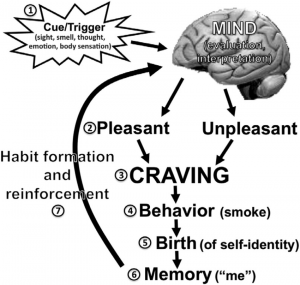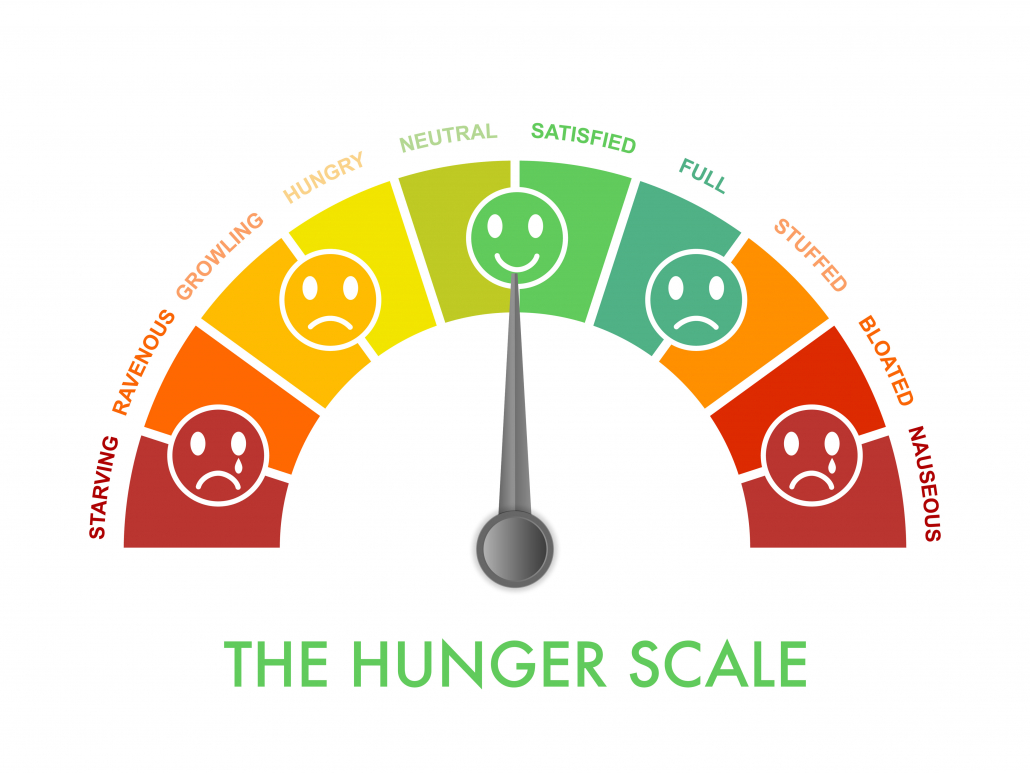We include products in articles we think are useful for our readers. If you buy products or services through links on our website, we may earn a small commission.
Mindful Eating: A Guide for Beginners

Mindful eating is a group of techniques that can help you become more aware and gain control over why, how, and what you eat.
This article explains what mindful eating is, how it benefits you, and what you can do to start mindful eating today.
Table of Contents
What is Mindful Eating?
Mindful eating is based on the Buddhist principles of mindfulness: Bringing non-judgmental moment-by-moment awareness to your actions and sensations.
By incorporating mindfulness with eating you are bringing your attention to your emotions, thoughts, and sensations around food. This helps to creae more enjoyment, increase gratitude, and support nourishing choices and habits.
Mindful eating means bringing awareness to:
- experiences in our lives that can lead to habitual emotions.
- how emotions can influence food cravings.
- how cravings can result in eating habits.
- how the body feels after eating certain foods.
- the expression of gratitude for the meal.
- the larger context of the meal: where and who the food came from, how it was made, and by who.
- the moment-by-moment experience of flavor, texture, and satiation.
- deep breathing as you eat–in certain practices.
Why Try Mindful Eating?
In modern Western society, stress management and weight control are challenged by the busy, fast-paced lives we live. With the popularity of fast and ultra-processed food, microwavables, and meal replacement bars, for many people eating has become mindless.
A 2011 USDA study found that most Americans spend some portion of their day eating while doing other things like watching TV, working, grooming, and driving. In fact, 20% of all American meals are consumed in the car.
As part of the Standard American Diet, at least 1 in 4 people eat fast food on a daily basis. And Americans consume 31% more packaged food than fresh food.
All this mindless consumption of processed foods contributes to numerous diseases and disorders including diabetes, heart disease, infertility, cancers, and autoimmune diseases.
When eating foods high in addictive added sugars, and when distraced, you can override and miss cues from your body that tell you when you’ve had enough to eat. Just as importantly, mindful eating is a powerful tool for enhancing deep enjoyment of healthy foods while bringing the profound benefits of mindfulness into your daily life.
How Mindful Eating Works
At the most basic level, mindful eating works by bringing awareness to the ways that experiences in life result in bodily and emotional desires, and how these desires result in cravings and eating choices.
To understand how the simple practice of noticing and tracking the cause and effect cycle around food can have profound outcomes for well-being, you need to know a bit more about Buddhis philosophy–specifically how Buddhists understand what “you” are in the first place. This brings us to the Buddhist concept called “dependent origination.”
Buddhists understand “you” as the momentary experience of a changing cycle. It works like this:
- You have an experience.
- Your experience triggers a memory.
- Your memory triggers an emotional response landing somewhere on a spectrum from pleasant to unpleasant.
- A desire or craving arises in the form of an urge to take action or behave in ways that either bring about the cessation of unpleasant feelings or maintain pleasant feelings.
- You identify with this entire process from experience to feeling to craving to action.
- This circuit of experience is your self-identity–what you experience as “I”.

Dependent origination. From Judson Brewer Ph.D
By becoming aware of each part of this cycle, you create spaces between them. In these spaces you can bring in healthy intentions and greater sensitivity to your body: Are you physically hungry? Or just emotionally hungry? Is there a better way to honor and feed that emotion?
| Mindless Eating | Mindful Eating |
| Eating while multitasking (i.e. driving, working, listening to a podcast, talking on the phone) | Being with your food and noticing the tastes, smells, textures, and how your body responds. |
| Eating impulsively when you have uncomfortable emotions | Eating only when you are physically hungry |
| Eating fast and feeling overly-stuffed | Eating slowly and noticing when you have had enough |
| Eating based on immediate cravings, usually foods that are high in processed carbs, extra salty, and sweet | Eating for the health of your body and wellbeing of your mind: low-carb, high-fat, whole foods |
| Eating based on external cues like when your plate is empty; when you see a drive-thru; when there is a box of donuts at work | Eating based on internal cues such as physical feelings of hunger or satiation |
Mindful Eating Health Benefits
Studies have shown that mindful eating can aid in the treatment of obesity, weight loss, eating disorders, and binge eating.
Weight Loss
Losing weight is hard, but keeping the weight off can be even more challenging. Researchers found that 85% of people with obesity who lose weight will return to or exceed their original weight in a few years.
Part of the challenge is that maintaining a lower weight requires long-term lifestyle changes.
Mindful eating improves weight loss by
- Rewiring habitual patterns of reacting to negative feelings
- Replacing impulsivity with awareness
- Improving self-control
- Increasing feelings of contentment
The effectiveness of mindful eating on weight loss is proven in numerous studies. For example, when a group of obese people attended a 6-week seminar on mindful eating, they lost an average of 9 pounds during the seminar and at the 12-week follow-up.
Even more dramatic results were achieved at a 6-month seminar for obese people that resulted in an average weight loss of 26lbs. 3 months after the seminar the participants showed no weight gain.
These mindful eating weight-loss results are remarkable when considering that around 85% of obese people who lose weight gain back what they lost or increase weight within a few years of a weight loss regimen.
Binge Eating
The stress hormone cortisol is directly involved with appetite regulation. When cortisol is high, it can trigger the body to cue hunger.
Binge eating is compulsive overeating used to cope with stress and anxiety. Studies find that higher levels of stress are associated with same-day binge eating.
Not surprisingly, research shows that obese patients report that stress is a trigger for binge eating.
Numerous studies show that mindful eating can dramatically reduce the severity and frequency of binge eating.
Mindful eating exercises have been shown to help people to differentiate stress triggers from physical hunger and make healthier choices.

How to Practice Mindful Eating?
Here are a few ideas to incorporate mindful eating exercises into your daily life:
- Slow down – Prior to eating, take a moment to pause, close your eyes, take 3 breaths. With each breath notice how it feels in your body. Then practice bringing this level of awareness to each bite. Studies show that eating slowly can increase your satiation reducing the likelihood of overeating.
- Practice gratitude – Take a look at everything you are about to eat. Imagine the path your food took to arrive at your plate. Offer gratitude to all the people responsible for growing your meal, packaging it, and preparing it. After your meal, take a moment to place your hand on your belly and offer gratitude to your body for its ability to eat, taste, and digest your food.
- Ritualize your trip to the grocery store – First, carve some time from your schedule to sit down and create your grocery list. Perhaps even light a candle or set an intention before you begin. Consider the health value of what you are purchasing and the benefit it will have on your body. When at the store, stick to your intention.
- Chew thoroughly – Chewing is the first step of your digestive process, and the more carefully you chew, the better your digestion will be. Chewing mindfully helps you slow down and respond more wisely to your body’s cues.
- Prepare with care – As you make your meal, let it be a present-centered experience. Instead of music, tune in to the process. Listen to the sounds of slicing vegetables or the meat sizzling in the pan. Smell the richness of the herbs and spices. By savoring the experience of preparation, you may find the meal tastes better and you need less to feel satisfied.
- Approach each bite with a beginner’s mind – Mindfulness teacher Jon Kabat-Zinn provided a mindfulness exercise known as the raisin-eating experience. Take one raisin and place it in front of you. Imagine you have just landed on planet earth for the first time. Pick up the raisin and experience it from this new lens – what do you notice? How does it feel in your hand? As you place the raisin between your lips and hold it there, what happens inside of you? As you take your first bite, what do you notice? This practice does not tell you what you should notice, but invites you to notice your own experience.
- Enjoy a family meal – Sustaining a practice of mindful eating can be easier when you practice with others. One study found that family meals centered around mindful eating showed immense potential in addressing youth obesity. Sharing stories about our food experiences can increase accountability and a sense of support.
As you can see, mindful eating is all about focusing your attention. If you’re just starting out you may find your attention wandering. But don’t be discouraged. If your attention wanders, just gently bring it back. Think of attention as a muscle. Each time you bring it back, it gets a little stronger.
The Takeaway
Mindful eating creates space between your triggers and responses, allowing you to break unhealthy habits, chose more nourishing foods, while bringing greater enjoyment and gratitude to your meals.
Incorporating consistent mindfulness exercises, such as meditation, yoga, mindful eating, and deep breathing, work together to improve the overall quality of your life.















